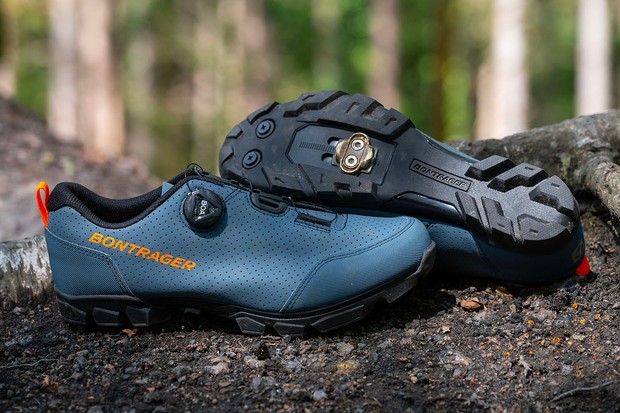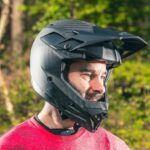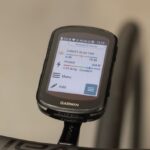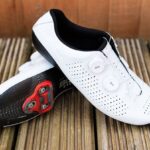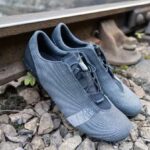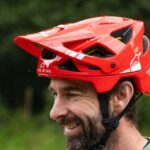Bontrager’s Evoke mountain bike shoes are designed to be proper all-rounders, tackling just about any off-road adventure you can think of – within reason.
Their spacious, breezy feel makes them ideal for long stints in the saddle on hot days, while the stiff sole is a real plus for those out-of-the-saddle hillclimb efforts.
And, just as Bontrager promises, the Evoke shoes are more than capable of being used for trail riding one day, then taking on gravel duties or commuting the next.
There is room for improvement though, especially when it comes to the closure and fit.
Table des matières
Bontrager Evoke shoes specifications and details

In a bid to keep things feeling light and airy, the Evoke’s synthetic upper is heavily perforated. The shoes also feature Bontrager’s ‘inForm Race’ fit, which the brand claims is a little roomier, but doesn’t scrimp when it comes to performance.
A reinforced toe bumper wraps around the front of the shoe, though it isn’t as tough or as rigid as others I’ve tested.
To lock the Evokes onto your feet, Bontrager provides a single Boa ratchet dial, which you can pop up for easy release.
In a bid to avoid weighing the Evokes down, there’s too much padding throughout the shoe. While the tongue’s padding is quite thin and firm, it’s a little more plush around the ankle cuff.
As with all mountain bike shoes, sole stiffness is a balancing act. While Bontrager rates the Evoke’s nylon composite sole at a six out of 14 on its stiffness index, there’s not all that much give when off the bike and walking.
Tachyon rubber tread blocks flank the cleat slots and cover the heel of the outsole.
Bontrager has covered the middle of the outsole in rubber too, just in case you’re caught short and can’t manage to clip back in. This’ll add just enough traction to prevent you slipping a pedal.
The cleat slots offer a reasonable amount of adjustment and have raised perpendicular lines running down the channel between them to help ensure you manage to get a nice and even setup between shoes.
At 774g for my pair of EU 42 shoes with Crankbrothers cleats fitted, they’re a reasonable weight, but certainly not as light as many rival shoes.
Bontrager Evoke shoes performance

Just as Bontrager intended, the Evoke shoes offer a reasonably roomy fit that feels comfortable from the get-go.
That said, it means the Boa dial has a lot of excess to rein in when you start battening down the hatches, and I found I needed to crank it up pretty tight to ensure the shoe felt secure when really pulling on the upstroke of every crank revolution.
Even then, you can still feel your feet lift slightly when really giving it some.
Thanks to that perforated upper, the shoes are fairly airy, too, which comes in handy on warmer days when you’re working hard.
Those perforations mean you’ll get wet feet when the rain starts coming down, though.
I found I was able to get the cleats just about far enough back towards the middle of my feet to make me feel comfortable. That meant my legs stayed fresh on long descents and bike control never seemed compromised – as can be the case when riding with cleats too far forward.
Clipping in and out felt free of any interference from the sole treads that surround the cleat. Thankfully, there’s just enough clearance that clogging shouldn’t be too much of an issue either.

Put the power down and there’s enough stiffness through the sole to ensure your watts are transferred efficiently into forward motion.
Despite that stiff sole, the Evokes never felt harsh or uncomfortable, partly down to the cushioning from the insole and the relatively neutral footbed, which I got on with really well.
Off the bike, even if you cinch up the Boa dial tightly, there’s still some heel lift, though the small amount of toe flex means you’ll be walking rather than waddling into the café when you stop for a mid-ride pick-me-up.
My only niggle with comfort came from the tongue, which I could feel digging in to the top of my foot on steeper descents that required dropping my heels and flexing my feet. That’s a small issue, though.
How do the Bontrager Evoke shoes compare?

I rode the Evokes back-to-back with a number of other shoes, including the Specialized Recon 2.0.
In terms of their all-rounder approach, I think both shoes work well for trail riding and could easily handle miles of gravel riding too.
That said, I think the Recons have the upper hand for a number of reasons.
Their fit doesn’t feel quite as generous as the Evokes, but the Recon 2.0s feel more secure on your feet when you’re really smashing the pedals.
The soles seem just as stiff, though the Recon 2.0s have more toe flex, making walking off the bike that bit more natural.
Overall comfort levels are pretty similar, but the Specialized shoe’s tongue is padded at the top and more comfortable in comparison. The Recon 2.0s are also lighter and feel airier.
Bontrager Evoke shoes bottom line

The Evoke shoes from Bontrager offer decent value for those looking for a trail riding shoe that’ll work on the gravel bike or commuter bike, too.
Thanks to the voluminous, supple upper, they’re comfortable, too, though you may find the top of the tongue digging in when you’re really flexing your feet.
They don’t lock on to your feet as well as other shoes either, though this is only really noticeable when giving the pedals a really hard time.
Power transfer and efficiency feel impressive, but the trade-off seems to be some heel lift when walking off the bike.
Otherwise, they’re a good set of shoes that’ll work well in a variety of situations – just as Bontrager intended.
How we tested | trail and XC clipless mountain bike shoes
We’ve tested nine of the newest and most interesting trail and cross-country focused clipless shoes.
To identify the key differences, we’ve gone out into the wilderness to pedal mile after mile, often with a different shoe on each foot. This may look weird, but there’s no better way to highlight those all-important details.
On top of that, doing long rides around battered trail centre loops and taking part in an XC race has helped us work out each pair’s strengths and weaknesses.

